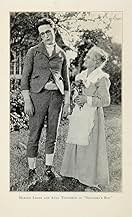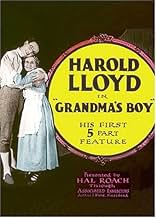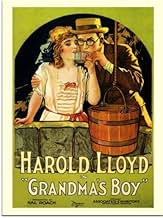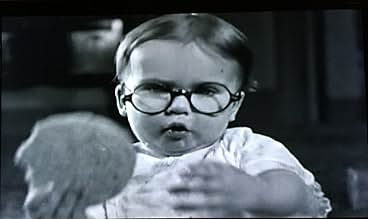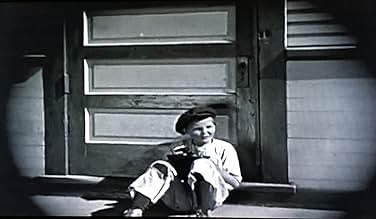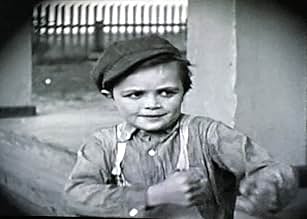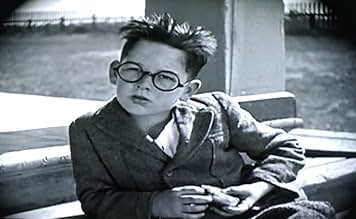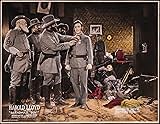IMDb RATING
7.0/10
2.2K
YOUR RATING
A meek young man must find the courage within when a rogue tramp menaces his home town.A meek young man must find the courage within when a rogue tramp menaces his home town.A meek young man must find the courage within when a rogue tramp menaces his home town.
- Awards
- 1 win total
Jack Morgan
- Little Boy with Grandma
- (scenes deleted)
Roy Brooks
- Townsman
- (uncredited)
Sammy Brooks
- Townsman
- (uncredited)
Jack Edwards
- Grandma's Boy as a Baby
- (uncredited)
William Gillespie
- Townsman
- (uncredited)
- …
John Hatton
- Schoolboy Bully #1
- (uncredited)
Wally Howe
- The Girl's Father
- (uncredited)
- …
Mark Jones
- Old Hag with Talisman
- (uncredited)
James T. Kelley
- Townsman
- (uncredited)
Gus Leonard
- Farmer
- (uncredited)
Gaylord Lloyd
- Townsman
- (uncredited)
George Rowe
- Townsman
- (uncredited)
Featured reviews
I think the best overall summary would be to call this a dramatic comedy. Harold Lloyd displays accomplished slapstick while at the same time being involved in the drama of catching a tramp causing a lot of problems for the town. An ongoing subplot involves the used-to-be school bully (now grown up) who continues to bully Harold and does his best to take his girl from him. It is not until Harold's grandma tells him about a special amulet that his grandfather used in the Civil War and got his courage from that he gets up the courage to take after the tramp and take on the bully. All of the action involves numerous slapstick antics that really make the movie. Yet, with all of that, the point still comes across that things don't give us courage and abilities. We get our courage to act from within ourselves. This movie reinforces that there were very good silent movies made and we can learn from them and have a lot of laughs at the same time.
About 20 years ago I was fortunate enough to see Harold Lloyd's first feature-length film, Grandma's Boy, at a public screening. I recall that it went over very well with the audience, that Harold was highly sympathetic in the lead role, and that I found the movie pleasant and engaging, with a stronger plot than some of Lloyd's later features. Now that I've rediscovered the film on DVD it's a pleasure to report that it holds up beautifully and, unlike some silent comedies, plays well on TV. Grandma's Boy is a richly atmospheric period piece that is sweet, funny, and suspenseful, and certainly ranks with Lloyd's best work. It's all the more impressive that this was his first attempt at a full-length feature, for it marks a genuine stylistic break with the sort of thing he'd been making up to this point. Unlike some of Harold's earlier, "gag happy" short comedies, this film offers a well structured story built around recognizable human beings who inhabit a basically realistic world. The story is more character-driven than gag-driven, and more relaxed in tempo than most of Lloyd's earlier films. Admittedly, some of the characters are a little cartoon-y, but they don't behave outlandishly or pick fights at the drop of a hat in order to get laughs. And while there are certainly plenty of laughs along the way, everything seems to unfold naturally, and nothing feels forced.
Grandma's Boy is set in the sleepy rural village of Blossom Bend, which, we are told, is "one of those slow towns where the Tuesday morning Express arrives Wednesday afternoon. If Monday's train gets out of the way." Except for a brief prologue and a flashback to the Civil War, the story takes place when the film was made, that is, in 1922, but in the sort of Town That Time Forgot that might have looked like a quaint throwback to some viewers even then. Harold plays a young man who lives with his grandmother, and is the kind of guy who would be called a wimp -- or worse -- nowadays. The prologue dramatizes Harold's lifelong reluctance to defend himself from bullies. He's a coward, he knows it, and he's miserable about it. On the other hand, Harold's grandmother is a peppery old lady who is not to be trifled with. (Anna Townsend plays this role, and she's wonderful). Grandma sympathizes with the boy's plight, yet also realizes she's coddled him long enough, and that he must find the courage within himself, even if getting him to that point requires trickery on her part.
This movie paints a nostalgic picture of small town life that was never so simple in reality, but, like the story of Tom Sawyer, it holds the powerful appeal of life as we wish it was. Period charm is a major element of the film's strength, but in order to appreciate it fully a modern viewer needs a certain amount of historical perspective. For example: during one scene, when Harold is forced to wear his grandfather's ancient suit to a party, his embarrassment may be hard for some to understand. The other party-goers think he looks strange in his 19th century frock coat, but their own clothing looks just as odd to us as Harold's "old-fashioned" suit does to them, especially the leading lady's massive hair ribbon. (Did that thing look funny to some viewers, even in 1922? I'll bet the flappers thought so!)
The film's best known sequence is a flashback to the Civil War, as Harold's Grandma tells him of his grandfather's exploits behind enemy lines. This is the funniest segment, deliberately played in a "heightened" manner like a hokey stage melodrama. I was especially fascinated by the witch who helps Harold's grandfather triumph over his enemies; she wears heavy stage makeup, emotes like crazy, and looks like she must have a gingerbread house somewhere back in the woods. All of this wacky over-playing is acceptable, dramatically speaking, because we eventually learn that Grandma's story is, well, not entirely true. It's interesting that Lloyd and his colleagues took this approach to the Civil War sequence, but the motivation is not hard to imagine: when this film was made there were plenty of actual Civil War veterans still around, and the war and its aftermath lingered as a painful memory for many. Perhaps the filmmakers chose to treat the war scenes as exaggerated melodrama in order to make the material more palatable to contemporary audiences. A few years later, when Buster Keaton made The General, he chose to treat the war with almost documentary-like realism while dropping black comedy gags into the mix, and some critics of the day felt his approach was in poor taste. Lloyd's version of the war is quite different from Keaton's but valid in its own way, and may well have influenced Keaton when he made his masterpiece.
As memorable as the Civil War sequence is, the most gripping section of the film depicts Harold's transformation from coward to hero, as he manages to subdue a dangerous tramp who has been terrorizing the town. (The tramp is played by Dick Sutherland, an enormous actor with an unforgettable face.) This is a terrifically suspenseful sequence, alternately funny and thrilling, and it's followed by a deeply satisfying finale in which this lifelong sissy applies the lessons he learned in dealing with the tramp to the bully who has tormented him since boyhood. And don't miss the delightful closing gag! Grandma's Boy is a film that leaves the viewer with a warm glow, one of the best movies Harold Lloyd ever made, and one of the top comedies of the silent era.
Grandma's Boy is set in the sleepy rural village of Blossom Bend, which, we are told, is "one of those slow towns where the Tuesday morning Express arrives Wednesday afternoon. If Monday's train gets out of the way." Except for a brief prologue and a flashback to the Civil War, the story takes place when the film was made, that is, in 1922, but in the sort of Town That Time Forgot that might have looked like a quaint throwback to some viewers even then. Harold plays a young man who lives with his grandmother, and is the kind of guy who would be called a wimp -- or worse -- nowadays. The prologue dramatizes Harold's lifelong reluctance to defend himself from bullies. He's a coward, he knows it, and he's miserable about it. On the other hand, Harold's grandmother is a peppery old lady who is not to be trifled with. (Anna Townsend plays this role, and she's wonderful). Grandma sympathizes with the boy's plight, yet also realizes she's coddled him long enough, and that he must find the courage within himself, even if getting him to that point requires trickery on her part.
This movie paints a nostalgic picture of small town life that was never so simple in reality, but, like the story of Tom Sawyer, it holds the powerful appeal of life as we wish it was. Period charm is a major element of the film's strength, but in order to appreciate it fully a modern viewer needs a certain amount of historical perspective. For example: during one scene, when Harold is forced to wear his grandfather's ancient suit to a party, his embarrassment may be hard for some to understand. The other party-goers think he looks strange in his 19th century frock coat, but their own clothing looks just as odd to us as Harold's "old-fashioned" suit does to them, especially the leading lady's massive hair ribbon. (Did that thing look funny to some viewers, even in 1922? I'll bet the flappers thought so!)
The film's best known sequence is a flashback to the Civil War, as Harold's Grandma tells him of his grandfather's exploits behind enemy lines. This is the funniest segment, deliberately played in a "heightened" manner like a hokey stage melodrama. I was especially fascinated by the witch who helps Harold's grandfather triumph over his enemies; she wears heavy stage makeup, emotes like crazy, and looks like she must have a gingerbread house somewhere back in the woods. All of this wacky over-playing is acceptable, dramatically speaking, because we eventually learn that Grandma's story is, well, not entirely true. It's interesting that Lloyd and his colleagues took this approach to the Civil War sequence, but the motivation is not hard to imagine: when this film was made there were plenty of actual Civil War veterans still around, and the war and its aftermath lingered as a painful memory for many. Perhaps the filmmakers chose to treat the war scenes as exaggerated melodrama in order to make the material more palatable to contemporary audiences. A few years later, when Buster Keaton made The General, he chose to treat the war with almost documentary-like realism while dropping black comedy gags into the mix, and some critics of the day felt his approach was in poor taste. Lloyd's version of the war is quite different from Keaton's but valid in its own way, and may well have influenced Keaton when he made his masterpiece.
As memorable as the Civil War sequence is, the most gripping section of the film depicts Harold's transformation from coward to hero, as he manages to subdue a dangerous tramp who has been terrorizing the town. (The tramp is played by Dick Sutherland, an enormous actor with an unforgettable face.) This is a terrifically suspenseful sequence, alternately funny and thrilling, and it's followed by a deeply satisfying finale in which this lifelong sissy applies the lessons he learned in dealing with the tramp to the bully who has tormented him since boyhood. And don't miss the delightful closing gag! Grandma's Boy is a film that leaves the viewer with a warm glow, one of the best movies Harold Lloyd ever made, and one of the top comedies of the silent era.
GRANDMA'S BOY is among the first silent comedies that focus on characterization. It is also Lloyd's breakthrough picture which set him on the rank of Chaplin and Keaton and we can easily see why. It's full of tightly linked, ingenious gags( even where he put his hat would serve as a link to later action ). It also keeps some acrobatic movements that reminds us of Lloyd's 2 reeler days. It has a strong story line, and consistent plot development and delicate performance from Lloyd as well. The Grandpa's Civil war episode is truly funny.
Harold Lloyd's first great feature pits him in his ideal homespun setting with a simple and archetypal plot in which the mild-mannered Boy gradually learns to overcome his cowardice - with the help of his loving grandmother - to become the toast of the town; in this respect, it predates the star's more celebrated THE FRESHMAN (1925) in being, above all, character-driven (with a dash of sentimentality). That said, perhaps the film's most hilarious scene is a typical one in which both Lloyd and his rival for the affections of leading lady Mildred Davis unwittingly mistake moth-balls from Lloyd's ancient costume (which had belonged to his grandfather) for sweets.
It's climaxed, however, by three lengthy and impressive set-pieces: the Civil War feat of the hero's grandfather (also played by Lloyd and remarkably anticipating Keaton's THE GENERAL [1927]); the chase leading up to the capture of the town bully by the newly-brave Lloyd (brought about by the presence of a Zuni doll - more than 50 years before such an artifact would achieve immortality via the classic made-for-TV compendium TRILOGY OF TERROR [1975]!); and our hero's settling of accounts with his mean-spirited rival, which features some rather physical tussling for this kind of film. As ever with Lloyd, apart from providing the requisite attention to gag structure and the creation of atmosphere, the film results in being quite technically proficient.
It's climaxed, however, by three lengthy and impressive set-pieces: the Civil War feat of the hero's grandfather (also played by Lloyd and remarkably anticipating Keaton's THE GENERAL [1927]); the chase leading up to the capture of the town bully by the newly-brave Lloyd (brought about by the presence of a Zuni doll - more than 50 years before such an artifact would achieve immortality via the classic made-for-TV compendium TRILOGY OF TERROR [1975]!); and our hero's settling of accounts with his mean-spirited rival, which features some rather physical tussling for this kind of film. As ever with Lloyd, apart from providing the requisite attention to gag structure and the creation of atmosphere, the film results in being quite technically proficient.
GRANDMA'S BOY is a terribly timid fellow until the old lady decides to instill some much needed courage into him.
This sweetly poignant and very funny film started off as a two-reeler, but star Harold Lloyd, with the approval of producer Hal Roach, kept adding gags until the completed picture ran about an hour. Harold also wanted something else - to instill a serious element to the story and his character, an innovation new to American comedy films.
He succeeded brilliantly, with the finished film a joy, blending the hilarious and the sentimental seamlessly. As always, Harold is a special treat to watch, his amazing athletic abilities made even more impressive by the fact that he was missing half of his right hand. The plot makes Harold deal with both a contemptible bully and a vicious tramp, giving our hero full opportunity for running, falling, leaping & almost endless fisticuffs, all of which he carries off with great skill and good humor. And just to show that his bag of tricks is not depleted Harold throws in an uproarious Civil War flashback to delight the viewer.
Lovely Mildred Davis plays the girl of Harold's dreams. Charles Stevenson as the Rival and Dick Sutherland as the Tramp both make wonderful villains. Noah Young, who so often played the heavy in Harold's films, here has the relatively small role as the sheriff of Blossom Bend. Best of all is sweet elderly Anna Townsend, playing Harold's little darling of a grandma; whether attacking the Tramp with a broom or rejoicing at her grandson's newly found courage, she remains the heart of this very special movie. Anna Townsend would die the following year, 1923, at the age of 78.
Robert Israel has composed an excellent film score which perfectly complements Harold's antics on the screen.
This sweetly poignant and very funny film started off as a two-reeler, but star Harold Lloyd, with the approval of producer Hal Roach, kept adding gags until the completed picture ran about an hour. Harold also wanted something else - to instill a serious element to the story and his character, an innovation new to American comedy films.
He succeeded brilliantly, with the finished film a joy, blending the hilarious and the sentimental seamlessly. As always, Harold is a special treat to watch, his amazing athletic abilities made even more impressive by the fact that he was missing half of his right hand. The plot makes Harold deal with both a contemptible bully and a vicious tramp, giving our hero full opportunity for running, falling, leaping & almost endless fisticuffs, all of which he carries off with great skill and good humor. And just to show that his bag of tricks is not depleted Harold throws in an uproarious Civil War flashback to delight the viewer.
Lovely Mildred Davis plays the girl of Harold's dreams. Charles Stevenson as the Rival and Dick Sutherland as the Tramp both make wonderful villains. Noah Young, who so often played the heavy in Harold's films, here has the relatively small role as the sheriff of Blossom Bend. Best of all is sweet elderly Anna Townsend, playing Harold's little darling of a grandma; whether attacking the Tramp with a broom or rejoicing at her grandson's newly found courage, she remains the heart of this very special movie. Anna Townsend would die the following year, 1923, at the age of 78.
Robert Israel has composed an excellent film score which perfectly complements Harold's antics on the screen.
Did you know
- TriviaOriginally intended as a serious movie, this film was altered by Harold Lloyd into a comedy by adding the gag scenes later on.
- GoofsGrandma's boy puts six mothballs in the chocolate box. His girl gives him one from the box, but when his rival later picks up two, there are seven mothballs in the box instead of five.
- Quotes
Title Card: .The place. BLOSSOM BEND: One of those slow towns where the Tuesday morning Express arrives Wednesday afternoon. If Monday's train gets out of the way.
- ConnectionsFeatured in American Masters: Harold Lloyd: The Third Genius (1989)
- SoundtracksYou Are the Ideal of My Dreams
(1910) (uncredited)
Music and Lyrics by Herbert Ingraham
Sheet music shown before The Girl plays it on piano
- How long is Grandma's Boy?Powered by Alexa
Details
Box office
- Budget
- $94,412 (estimated)
- Runtime1 hour
- Color
- Sound mix
- Aspect ratio
- 1.33 : 1
Contribute to this page
Suggest an edit or add missing content


